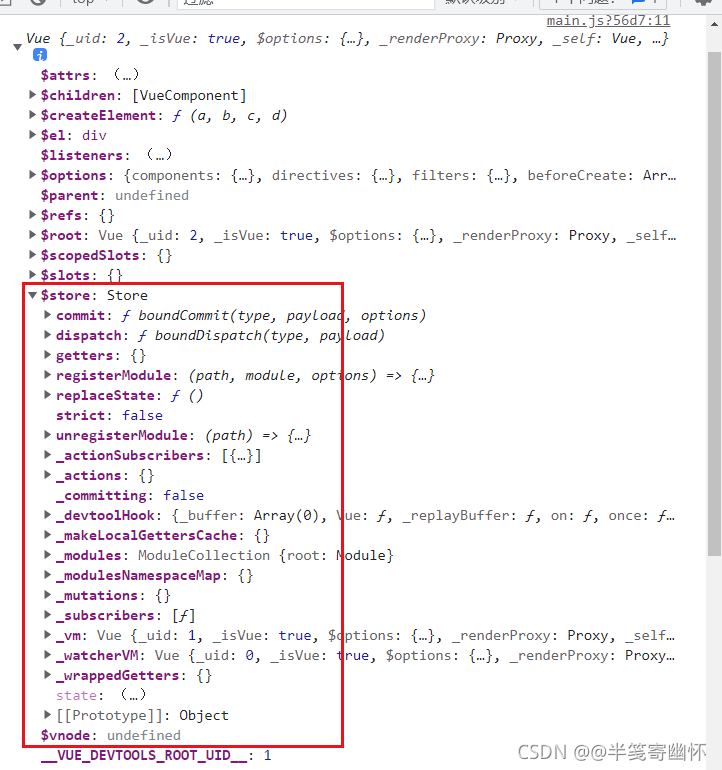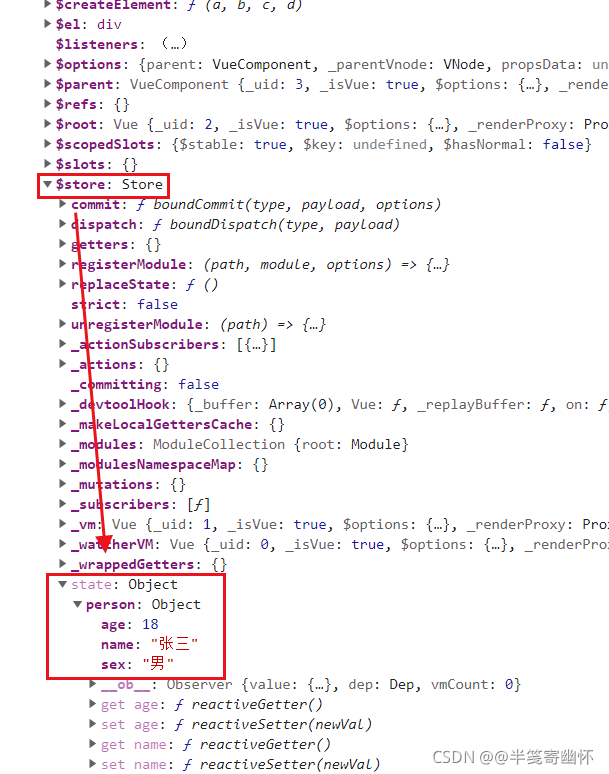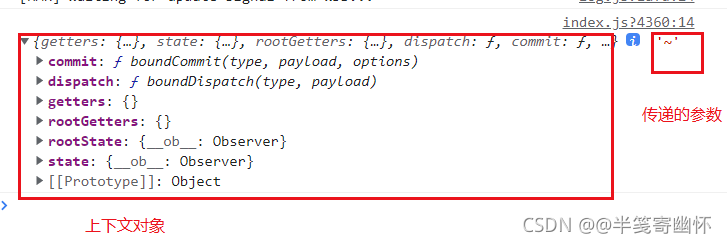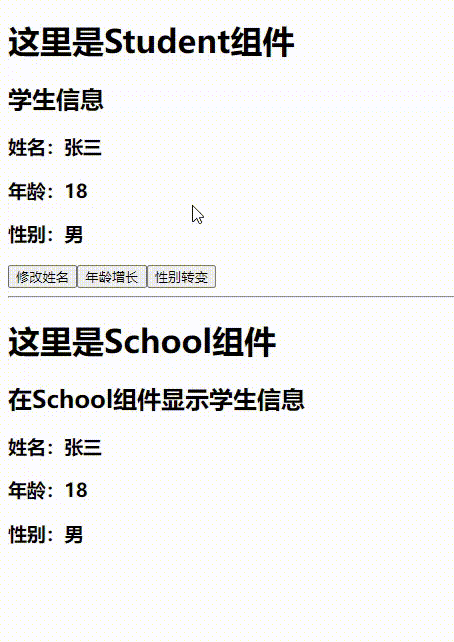在学习vuex之前,我们需要先了解一下vuex是什么。在vuex的官网,他是这样定义的:Vuex 是一个专为 Vue.js 应用程序开发的状态管理模式。说的非常高大尚,我个人的理解就是将数据集中管理,然后通过某些特地的api可以使用到这其中的数据,对其进行某些操作。那么这样做有什么意义呢?首先是公共的数据能够集中管理,使用api使在该项目中的每一个所需要该数据的组件都能够使用,下面我们来讲一下如何使用该插件。
1、安装和配置Vuex
1) vuex是一个插件,所以我们需要通过npm指令安装。
npm i vuex
2) 在main.js人口文件引入Vuex,插件需要应用就需要将插件应用Vue.use(Vuex),这个是直接在main.js直接写Vuex的部分代码,不符合模块化这个思路,所以不建议这样去写。在开发中如果使用到vuex,一般是创建一个名为store的文件夹,在此文件夹下有一个index.js文件,在这写对应的vuex代码。
import Vue from 'vue'
import App from './App.vue'
// 引入Vuex
import Vuex from 'vuex'
Vue.use(Vuex)
const actions = {
}
const mutations = {
}
const state = {
perosn: {
name: '张三',
age: 18,
sex: '男'
}
}
const store = new Vuex.Store({
actions, mutations, state
})
const vc = new Vue({
render: h => h(App),
store,
}).$mount('#app')
console.log(vc);
3) 这里是使用模块化写vuex代码,使用的是默认暴露,有一个要点要说一下,Vue.use必须写在这个文件里面,如果在main.js写Vue.use(Vuex),由于框架先解析import里面文件,在外面写的Vue.use(Vuex)不能被里面的识别到,所有会报错。到这里Vuex的配置就好了,下面我们写组件来观察这个Vuex中的数据如何获取和修改。
// 这里写关于store的代码
// 引入vue
import Vue from 'vue'
// 引入Vuex
import Vuex from 'vuex'
Vue.use(Vuex)
const actions = {
}
const mutations = {
}
const state = {
person: {
name: '张三',
age: 18,
sex: '男'
}
}
export default new Vuex.Store({
actions, mutations, state
})
配置完成后在控制台输出Vue对象可以看见

2、数据的获取
我们在store->index.js->state中存储的person数据,最后都出现在$store->state->person中,那么我们在组件中想获取数据可以通过在mounted钩子中将此数据重新赋给data中新定义的对象,或者通过$store.state.person的方法将数据取出。

3、数据的修改
这里数据修改需要了解Vue工作原理,state是存放数据的地方,Vue Components是定义的组件,在组件中需要通过this.$store.dispatch();将数据传递给Actions,在这个地方可以经过一些逻辑处理,以及发送ajax请求,将数据处理后继续向下传递,dispatch()传递两个参数,第一个传递个下一个函数的函数名,第二个参数传递数据。在Actions中,我们使用commit向Mutations传递数据,并在这里将数据直接修改,然后会自动传递给State,数据修改就算完成了。

1) Student.vue中的代码
<template>
<div>
<h1>这里是Student组件</h1>
<h2>学生信息</h2>
<h3>姓名:{{ $store.state.person.name }}</h3>
<h3>年龄:{{ $store.state.person.age }}</h3>
<h3>性别:{{ $store.state.person.sex }}</h3>
<!-- 点击触发click事件触发回调 -->
<button @click="updateName">修改姓名</button>
<button @click="addAge">年龄增长</button>
<button @click="changeSex">性别转变</button>
</div>
</template>
<script>
export default {
name: "Student",
methods: {
// 点击触发的回调
updateName() {
// 从组件向Acitons传递数据
this.$store.dispatch("name", "~");
},
addAge() {
// 从组件直接向Mutations直接传递数据
this.$store.commit("ADDAGE", 1);
},
changeSex() {
this.$store.dispatch("sex");
},
},
};
</script>
<style></style>
2) store->index.js代码
// 这里写关于store的代码
// 因引入vue
import Vue from 'vue'
// 引入Vuex
import Vuex from 'vuex'
Vue.use(Vuex)
// Actions
const actions = {
// 组件传递过来的,函数必须为name,是有组件dispatch()第一个参数决定
// 函数有两个参数 第一个是上下文对象,第二个是dispatch()第二个参数传过来的数据
name(context, value) {
console.log(context, value);
context.commit('NAME', value)
},
// 组件传递过来的,函数必须为name,是有组件dispatch()第一个参数决定,前面没有传递参数,则第二个没有数据
sex(context) {
if (context.state.person.sex === '男') {
context.commit('SEX', '女')
} else {
context.commit('SEX', '男')
}
}
}
// Mutations
const mutations = {
NAME(context, value) {
context.person.name += value
},
// 逻辑简单,直接+1可以不经过Actions直接进入Mutations
ADDAGE(context, value) {
context.person.age += value
},
SEX(context, value) {
context.person.sex = value
}
}
// State
const state = {
person: {
name: '张三',
age: 18,
sex: '男'
}
}
export default new Vuex.Store({
actions, mutations, state
})

4、总结
最后我们来展示一下显示结果

如有误,请斧正!!!




 本文介绍了Vuex的基础知识,包括安装配置、数据获取和修改。首先讲解了Vuex作为状态管理模式的作用,接着详细阐述了如何通过模块化方式配置Vuex,以及在组件中如何获取和修改 Vuex 中的数据。最后,对Vuex的使用进行了简单总结。
本文介绍了Vuex的基础知识,包括安装配置、数据获取和修改。首先讲解了Vuex作为状态管理模式的作用,接着详细阐述了如何通过模块化方式配置Vuex,以及在组件中如何获取和修改 Vuex 中的数据。最后,对Vuex的使用进行了简单总结。
















 2395
2395

 被折叠的 条评论
为什么被折叠?
被折叠的 条评论
为什么被折叠?








